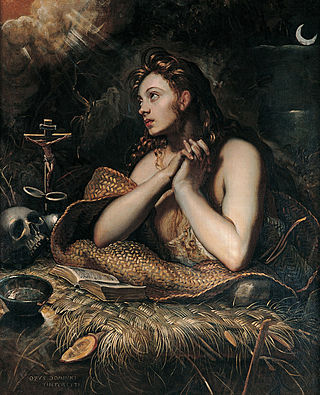
Mary Magdalene was a woman who, according to the four canonical gospels, traveled with Jesus as one of his followers and was a witness to his crucifixion and resurrection. She is mentioned by name twelve times in the canonical gospels, more than most of the apostles and more than any other woman in the gospels, other than Jesus's family. Mary's epithet Magdalene may be a toponymic surname, meaning that she came from the town of Magdala, a fishing town on the western shore of the Sea of Galilee in Roman Judea.

Mary of Bethany is a biblical figure mentioned by name in the Gospel of John and probably the Gospel of Luke in the Christian New Testament. Together with her siblings Lazarus and Martha, she is described as living in the village of Bethany, a small village in Judaea to the south of the Mount of Olives near Jerusalem.

James the Less is a figure of early Christianity. He is also called "the Minor", "the Little", "the Lesser", or "the Younger", according to translation, James is styled "the Less" to distinguish him from the Apostle James the Great with "Less" meaning younger or shorter, rather than less important. James the Great was the brother of John the Apostle.

James the Just, or a variation of James, brother of the Lord, was a brother of Jesus, according to the New Testament. He was the first leader of the Jerusalem Church of the Apostolic Age. Traditionally, it is believed he was martyred in AD 62 or 69 by being stoned to death by the Pharisees on order of High Priest Ananus ben Ananus. James, Joses, Simon, and Judas are mentioned as the brothers or siblings of Jesus as well as two or more unnamed sisters.
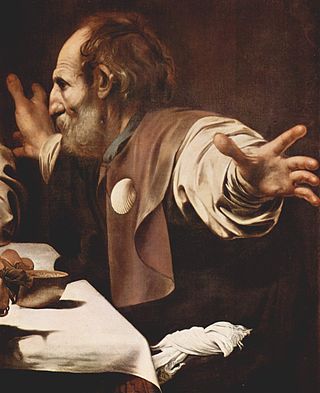
Cleopas, also spelled Cleophas, was a figure of early Christianity, one of the two disciples who encountered Jesus during the Road to Emmaus appearance in Luke 24:13–32.
Joses is a name, usually regarded as a form of Joseph, occurring many times in the New Testament:

In Christianity, a disciple is a dedicated follower of Jesus. This term is found in the New Testament only in the Gospels and Acts. In the ancient world, a disciple is a follower or adherent of a teacher. Discipleship is not the same as being a student in the modern sense. A disciple in the ancient biblical world actively imitated both the life and teaching of the master. It was a deliberate apprenticeship which made the fully formed disciple a living copy of the master.

In the New Testament, Salome was a follower of Jesus who appears briefly in the canonical gospels and in apocryphal writings. She is named by Mark as present at the crucifixion and as one of the Myrrhbearers, the women who found Jesus's empty tomb. Interpretation has further identified her with other women who are mentioned but not named in the canonical gospels. In particular, she is often identified as the wife of Zebedee, the mother of James and John, two of the Twelve apostles. In medieval tradition Salome was counted as one of the Three Marys who were daughters of Saint Anne, so making her the sister or half-sister of Mary, mother of Jesus.
Clopas is a figure of early Christianity. The name appears in the New Testament, specifically in John 19:25:
Near the cross of Jesus stood his mother, his mother's sister, Mary the wife of Clopas, and Mary Magdalene.

According to the Gospel of John, Mary of Clopas was one of the women present at the crucifixion of Jesus and bringing supplies for his funeral. The expression Mary of Clopas in the Greek text is ambiguous as to whether Mary was the daughter or wife of Clopas, but exegesis has commonly favoured the reading "wife of Clopas". Hegesippus identified Clopas as a brother of Joseph. In the latest official edition of the Roman Martyrology of the Catholic Church she is commemorated with Salome on April 24th.
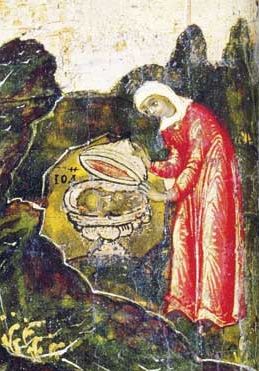
Joanna, the wife of Chuza, is a woman mentioned in the gospels who was healed by Jesus and later supported him and his disciples in their travels. She is one of the women recorded in the Gospel of Luke as accompanying Jesus and the twelve apostles and as a witness to Jesus' resurrection. Her husband was Chuza, who managed the household of Herod Antipas, the ruler of Galilee; this is the origin of the distinguishing epithet commonly attached to her name, differentiating her from other figures named Joanna or Joanne.

Matthew 27:61 is the sixty-first verse of the twenty-seventh chapter of the Gospel of Matthew in the New Testament. This verse describes two women waiting by the Tomb of Jesus after the crucifixion.

Matthew 27:55–56 are the fifty-sixth and fifty-seventh verses of the twenty-seventh chapter of the Gospel of Matthew in the New Testament. The crucifixion and death of Jesus have just occurred, and these verses make note of a group of women who were present at that event.

The Three Marys are women mentioned in the canonical gospels' narratives of the crucifixion and resurrection of Jesus. Mary was the most common name for Jewish women of the period.
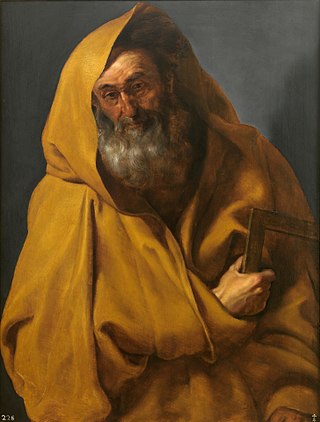
James, son of Alphaeus was one of the Twelve Apostles of Jesus, appearing under this name in all three of the Synoptic Gospels' lists of the apostles. He is generally identified with James the Less and commonly known by that name in church tradition. He is also labelled "the Minor", "the Little", "the Lesser", or "the Younger", according to translation. He is distinct from James, son of Zebedee and in some interpretations also from James, brother of Jesus. He appears only four times in the New Testament, each time in a list of the twelve apostles.

Mary, mother of James is identified in the synoptic gospels as one of the women who went to Jesus' tomb after he was buried. Mark 16:1 and Luke 24:10 refer to "Mary the mother of James" as one of the Myrrhbearers, the women who went to the tomb of Jesus.

In Eastern Orthodox Christian tradition the Myrrhbearers are the individuals mentioned in the New Testament who were directly involved in the burial or who discovered the empty tomb following the resurrection of Jesus. The term traditionally refers to the women who came with myrrh to the tomb of Christ early in the morning to find it empty. Also included are Joseph of Arimathea and Nicodemus, who took the body of Jesus down from the cross, anointed it with myrrh and aloes, wrapped it in clean linen, and placed it in a new tomb. In Western Christianity, the women at the tomb, the Three Marys or other variants are the terms normally used.
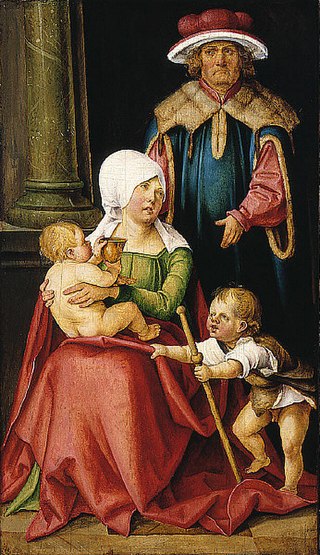
Zebedee, according to all four Canonical Gospels, was the father of James and John, two disciples of Jesus. The gospels also suggest that he was the husband of Salome; whereas Mark 15:40 names the women present at the crucifixion as "Mary Magdalene, and Mary the mother of James and of Joses, and Salome," the parallel passage in Matthew 27:56 has "Mary Magdalene, and Mary the mother of James and Joses, and the mother of Zebedee's children." The Catholic Encyclopedia concludes that the Salome of Mark 15:40 is probably identical with the mother of the sons of Zebedee in Matthew.

The name Mary, appears 54 times in the New Testament, in 49 verses. It was the single most popular female name among Jews of the Roman province of Judaea at the time, borne by about one in four women, and most of the New Testament references to Mary provide only the barest identifying information. Scholars and traditions therefore differ as to how many distinct women these references represent and which of them refer to the same person.















